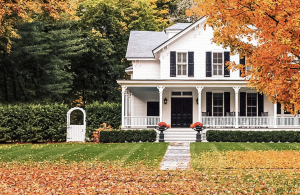
Crisp, golden leaves surround a beautiful home – the perfect fall scene.
Photography by: Shannon Shipman
As the leaves change and the air gains a coolness, it’s an ideal moment to welcome the comfortable atmosphere of autumn!
However, before you can fully relax with a hot drink and a good book, your residence requires some attention to prepare for colder conditions. Fall home upkeep is not solely about appearance; it’s a sensible financial decision that can avert expensive repairs later, improve your home’s energy use, and guarantee your comfort throughout the season. Taking these forward-thinking actions now means fewer concerns and more enjoyment as temperatures decrease, ensuring your home serves as a warm shelter from the elements.
Let’s examine some of the most important fall preparation jobs to ready your home for the cold. Firstly, making your windows and doors resistant to weather is vital for stopping drafts and heat loss. Check for any openings larger than 1/8 inch around the frames and seal them with quality caulk. Applying weather stripping to the edges of doors and windows, and installing door sweeps, can significantly help keep warm air inside and cold air outside. This straightforward action not only increases comfort but also directly affects those high energy bills. It is a fundamental part of getting ready for colder weather!
Another crucial job is checking and cleaning your gutters. Blocked gutters can cause water to accumulate, potentially damaging your foundation, roof, and garden. Ensure your gutters are angled correctly towards the downspouts and remove any leaves, twigs, or debris.
Now, let’s focus on specific areas often overlooked during fall preparation. Your attic significantly influences your home’s overall energy efficiency and protection. Take time to inspect it for any openings or leaks, particularly on a sunny day when you can see light coming through. Sufficient insulation is key here; if you can see the tops of your ceiling beams, it’s probably time to add more. Ensuring good airflow in the attic also helps manage temperature and moisture, preventing problems like ice buildup on the roof edges.
Improving your home’s general energy efficiency can result in considerable savings on heating expenses and make your living space much more comfortable. Besides sealing obvious gaps around windows and doors, take time to check for smaller air leaks around electrical sockets, switch plates, and pipe entry points, and seal them. Adding extra insulation where needed, not just in the attic but also in walls and underfloor spaces, further strengthens your home’s resistance to the cold.
Lastly, let’s not forget about maintaining your exterior areas. Regularly checking your roof and exterior walls for any signs of damage or wear is important. Look for missing roof tiles, intact metal flashing around chimneys and vents, and any cracks or gaps in your siding that could let moisture in. Trimming trees and bushes, especially branches that hang over your house or near power lines, can prevent potential damage during winter storms and also reduce the amount of debris that collects in your gutters.
